For the purpose of protecting your investment, whether it be a Zambuto
mirror or a Lockwood mirror, or by any other name, we have a
recommended list of those to whom we are willing to entrust our
mirrors. This does not mean there are not others who can also do the
job, but rather these are our top recommendations.
We wish to point out that just because any entity calls themselves a
coater, and regardless of how long they may have been in business, this
does not guarantee they know how to safely handle your optical surface.
Over the years we have come across numerous examples of optical
surfaces being damaged, ranging from mild to severe.
This list does not necessarily exclude any other coater, but what we
suggest is if you own a Zambuto or Lockwood mirror and wish to have
service provided by someone not on this list, we strongly recommend you
check with us first. Failing to do so may put your investment at risk.
The following are companies who have serviced Zambuto and/or Lockwood
mirrors that we can recommend on an ongoing basis.
We will mention here that Zambuto Optical is only coating their own
mirrors currently (as of summer 2021) due to high workload.
Zambuto Optical Company
provides a full service where the optical surface is examined and all
aspects of findings are communicated with the customer at each step of
the process as needed.
Feel free to check with Mike Lockwood or Carl Zambuto if you have any
further questions concerning your LCO or ZOC mirrors.
-Mike
Lockwood, Lockwood Custom Optics
-Carl Zambuto, Zambuto Optical Company
|
More
thoughts on coating
Mike
Lockwood
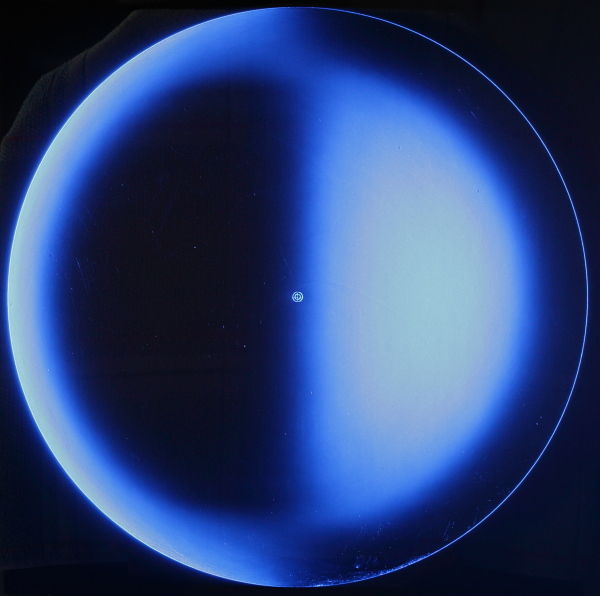 The
above
message was written by Carl Zambuto and myself, and was prompted by our
personal and direct experiences with mirrors getting
damaged by coaters. The
above
message was written by Carl Zambuto and myself, and was prompted by our
personal and direct experiences with mirrors getting
damaged by coaters.
This part of the article is written by me alone.
Recently (well not so recently now) a large mirror that I made was damaged by a coater, so, to
drive the point home I decided to
include some photos of the damage here.
Bottom line, if you are getting one of my my mirrors recoated,
please ask me first BEFORE you send
it off for re-coating, and ask Carl first
if you are having one of his mirrors recoated.
And by "ask me", I mean email me or call me. I do NOT mean go on
Cloudy Nights and ask.
People there tend to promote their "favorite" coater only, often
with few or no reasons to back it up, or perhaps they have a hidden
agenda. I will say that a search on CN for coating issues will
turn up some interesting results.
The image at right shows what a good, smooth mirror looks like
after figuring.
There is a center mark scribed into the surface, and there is a little
dirt on the surface, but it looks very smooth over most of the surface.
That is, the transitions from shadow to light are very
smooth, and there is little or no texture or roughness seen on the
optical surface.
However, the horrific image below provides a particularly memorable
example
of the damage that nasty chemicals and aluminum splatter can do to
a mirror.
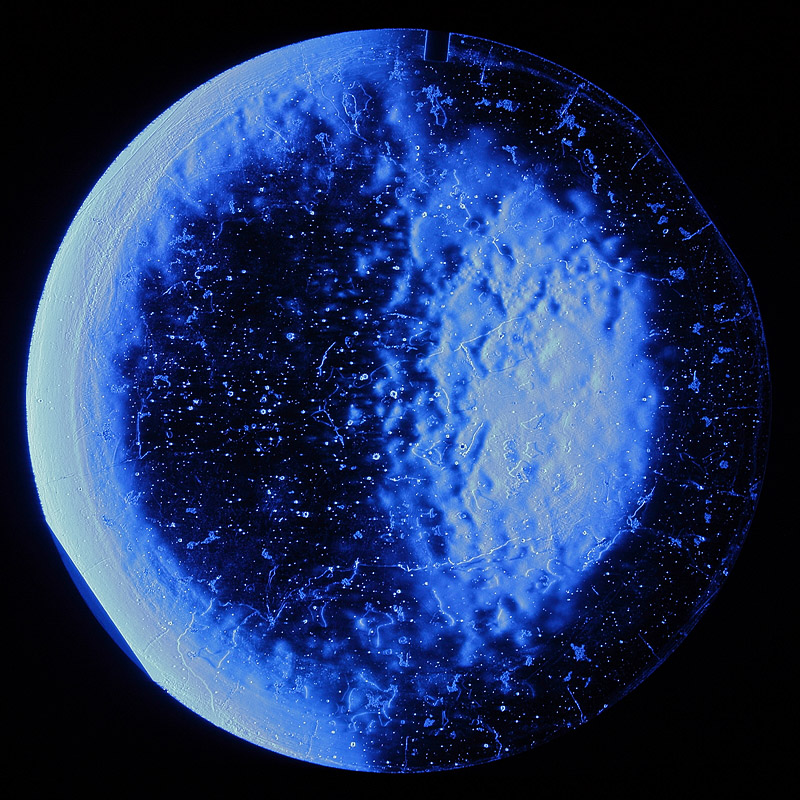
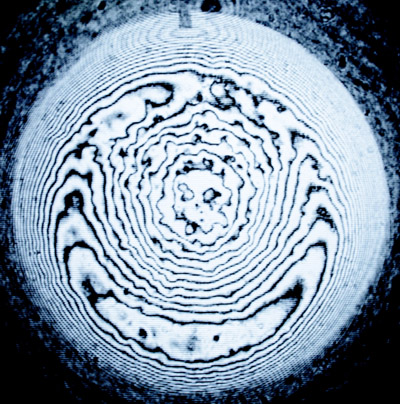 Though
glass is
normally not harmed by mild acids, leaving strong
acids on glass for long periods of time can cause damage that will
actually change the optical figure, or shape of the mirror.
Caustic solutions can harm glass in a severe manner rapidly,
and should not be used on glass. Though
glass is
normally not harmed by mild acids, leaving strong
acids on glass for long periods of time can cause damage that will
actually change the optical figure, or shape of the mirror.
Caustic solutions can harm glass in a severe manner rapidly,
and should not be used on glass.
In the image above, features appear to show a "shoreline" where the
chemical
action stopped, not quite filling the entire mirror's curve.
The rest of the mirror's surface is filled with irregular
damage. Additionally, molten aluminum somehow
splattered on the surface during coating, causing damage in small areas
that resemble bubbles in the surface.
An interferogram of the same mirror seen above is shown here at right.
The "wiggles" in the fringes help to quantify the damage done on
the
optical surface. In some places it is as much as 1/2-wave on
the wavefront, and it appears in a very irregular manner. The
damage has even caused a frightening sort of "face" to appear in the
center of the
mirror!
The roughness results in large slope errors that throw light well
outside of the desired image size for a star, bloating the star image
and destroying the ability of the telescope to detect faint objects and
produce high-resolution images. We tested the mirror, in the
damaged condition shown here, and that is exactly what the images
showed. Instead of tight points, stars were fuzzy blobs at best.
Fortunately insurance paid for the rework of the mirror, but this is
quite rare in my experience, and we were fortunate. After
that, the images were superb and are now yielding valuable scientific
data.
The images below were taken by Carl Zambuto, and show before and after images of some type of damage to
the optical surface of a different mirror, using a Ronchi grating for
testing. Obviously the damaged optical surface is on the right.
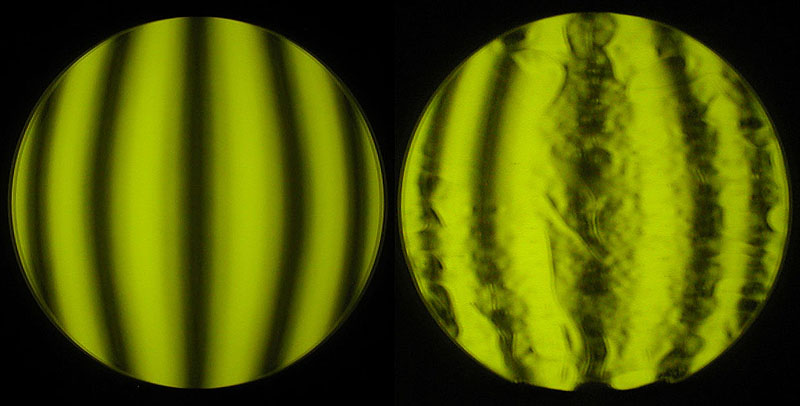
Again, the images produced by the telescope after the damage was done
were noticeably inferior to the original, smooth-figured mirror shown
on the left.
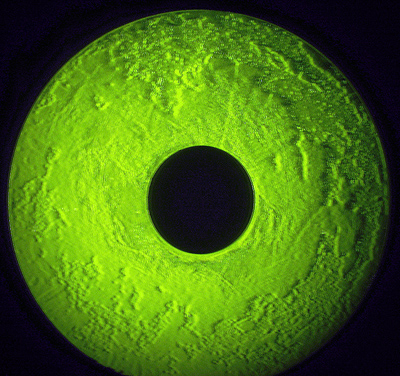
Finally,
at right we see another mirror that has been damaged by some sort of
harsh chemical during stripping or cleaning. If it is possible
for LCO to measure this mirror with their interferometer, the results
will be shown here.
The three mirrors pictured in this article were all damaged by different coaters.
The initial coating of a mirror is the least dangerous - the coater is
working with clean, freshly polished glass, which just needs a thorough
cleaning. Nasty chemicals should not be required.
Most of the time just about any coater will get this first
coating right.
However, when sending a mirror in for recoating, there is no telling
what might be used to strip the coating, and this is a very important
detail. (LCO uses Ferric Chloride or a Green River solution
for safe coating stripping.) This is yet another reason that
coatings should not be allowed to degrade too long, since this makes
them even more difficult to strip, which may encourage some to get out
the really nasty chemicals.
When something goes wrong during the coating run, the
coating will need to be stripped and re-done. This happens to
the best coaters, but they know how to safely strip the bad coating and
clean the mirror so that it is ready to receive a fresh coating that
will adhere tightly to the glass.
Opticians, or people who have done optical work, generally know how to
treat an
optical surface without damaging it. Many other experienced
coating houses do, too, but clearly not all of them.
Based
on my experience, I would advise people to stay away from companies
that require large amounts of time to coat a mirror (2-3 weeks is
normal, months is not), and those that you have trouble communicating
with. These are not good signs.
Again, inclusion in the above list of recommended coaters does not mean
that those are the only coaters who know what they are doing. It
means that those are the coaters who we work with regularly, have
pricing that is reasonable for amateur telescope optics, and who adhere
to stripping and cleaning prodedures that we are comfortable with.
Be careful, and if you have questions, contact me.
|
 The
above
message was written by Carl Zambuto and myself, and was prompted by our
personal and direct experiences with mirrors getting
damaged by coaters.
The
above
message was written by Carl Zambuto and myself, and was prompted by our
personal and direct experiences with mirrors getting
damaged by coaters.
 Though
glass is
normally not harmed by mild acids, leaving strong
acids on glass for long periods of time can cause damage that will
actually change the optical figure, or shape of the mirror.
Caustic solutions can harm glass in a severe manner rapidly,
and should not be used on glass.
Though
glass is
normally not harmed by mild acids, leaving strong
acids on glass for long periods of time can cause damage that will
actually change the optical figure, or shape of the mirror.
Caustic solutions can harm glass in a severe manner rapidly,
and should not be used on glass.
